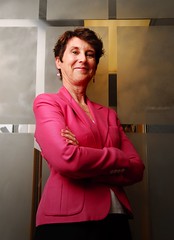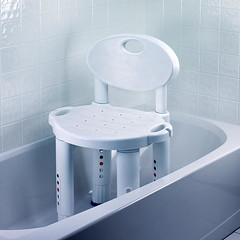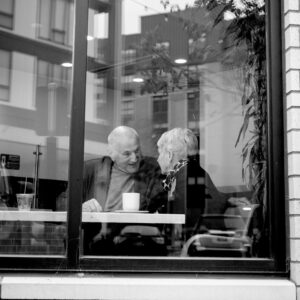A Question For You?
Do You Use the F Word?
FACILITY. I’ve used it a lot, but today I’m eliminating it from my vocabulary. Who wants to live in a facility? Guess what, honey, I’m moving to the FACILITY.' Yippeeee.Language triggers visions in the mind. Would you rather go to the ballpark or the stadium? Ballpark connotes smaller, open air, blue skies, maybe ivy on the walls. When I hear stadium I think of a concrete mass in the middle of a sea of parking lots. There’s a reason Major League Baseball doesn’t use the word 'stadium' anymore or why the American Association of Intellectual and Developmental Disabilities changed its name from the American Association on Mental Retardation, or some people use the phrase 'rightsize' instead of 'downsize' …In our Age Wave study, we asked baby boomers about several words in our profession. They can’t stand facility. And they don’t like campus. They really don’t like 'nursing home.' The word they embraced? Community. Makes total sense. Community vs. facility. One is much warmer, more inclusive, more vibrant, and people have lived in communities all of their life. Here’s an interesting perspective on language from Elite Care, a senior housing company in Oregon:We adopt a new vocabulary to erase debilitating stereotypes. Think about typically used elder care terms such as 'assisted,' 'caregiver,' 'administrator,' 'aide,' 'nurse,' and 'facility.' These words imply sickness, disability, and mindsets that inhibit creation of healthy power structures. Then consider words like 'facilitate,' 'elder,' 'extended family,' 'Life Enhancing Tasks,'„¢ and Neighborhood Coordinator. This new vocabulary does not make elders 'objects of care,' or make staff overprotect residents, because of stereotypes bolstered by language.Here’s another look at language from Paul Kleyman, editor of Aging Today, and a survey he directed at the American Society on Aging:In the June 2007 ASA Connection, readers answering our “Quick Question” about terms for people ages 65-plus overwhelmingly favored older adults, with elders running second. Now, thanks to a new study from the Journalists Exchange on Aging, we have a chance to see how reporters and editors view the issue -- and it turns out that both terms also made the journalists’ preferred list. By contrast, senior citizen found little favor in either camp: The JEOA study dismisses the label as “euphemistically sour,” and only 10.8 percent of the “Quick Question” respondents found it acceptable. Interestingly, in the survey we did of Minnesota baby boomers, 'senior' was preferred by 48% of respondents, 40% preferred 'older adult' and only 9% liked 'elder' the best. What is abundantly clear, however, is that there is a huge opportunity to change the language of aging services. What are words that you’d like to see changed?
50, 60, 70, 80, 90, 100, 110, … Models Wanted
AARP The Magazine is looking for the Faces of 50+€”real men and women (no professionals, please!) who look and feel great at 50 and beyond. Selected models may appear in fashion and beauty articles in AARP The Magazine throughout 2008. It’s free and easy to nominate someone or yourself online. The deadline is October 15th.
50, 60, 70, 80, 90, 100, 110... Models Wanted
AARP The Magazine is looking for the Faces of 50+€”real men and women (no professionals, please!) who look and feel great at 50 and beyond. Selected models may appear in fashion and beauty articles in AARP The Magazine throughout 2008. It’s free and easy to nominate someone or yourself online. The deadline is October 15th.
Secrets in Successful Aging From Around the Globe

National Geographic Magazine about two years ago traveled the world and looked at several communities and their secrets for longevity. You can watch a video clip from their travels here. Here are a few interesting things they learned about successful aging:From Sardinia in Italy, where men reach 100 at a rate more than twice as high as the average for Italy, they took these tips:- Drink red wine (in moderation)- Share the work burden with spouse- Eat pecorino cheese (and other omega-3 foods)From Seventh-day Adventists in California who live four to 10 years longer than the state’s average, they took away these tips for longevity:- Eat nuts and beans- Observe the Sabbath- Have faithIn Japan, Okinawans' average life expectancy of 82 years is among the longest in the world. Tips from Japan:- Keep lifelong friends- Eat small portions- Find purposeThings they learned that were common to all three communities were:- Don’t smoke- Put family first- Be active every day- Keep socially engaged- Eat fruits, vegetables and whole grainsAging … it is all about living. Have a great Labor Day Weekend. See you next week.
A Health Club For the Mind
That’s what the Osher Lifelong Learning Institute at the University of Minnesota is. It’s a membership group of older adults who love learning. The only precertifications you have to bring to class are: experience and curiosity. Classes for the next 8-week session begin September 24th. Go here for a course catalog. Members pay $195 annually for access to classes, which are held during the day. They have more than 180 classes featuring a variety of interesting topics, including: The Geology of the Gunflint Trail, The Art of Bob Dylan; U.S. Presidents: Myths and Realities; and An Elder’s Advantage.
Lakeshore’s Fall Semester StartingLearning is so important to successful aging. Lakeshore in Duluth under the leadership of Chaplain Alice Olson is starting its fall lifelong learning series on September 17th. Courses, which begin on September 17th, will be taught by Duluth-area experts, including several from Lakeshore. Topics will include Your Role in Saving the Environment to Preserving One’s Ears (and hearing) for Years to The Kinesthetic and Creative Power of Drawing to An Insider’s Guide to Norway. For readers in Duluth, contact Chaplain Alice Olson (aliceolson@ecumen.org) for more information.
Lessons in Leadership From Elmer Andersen
Elmer Andersen, the former Governor of Minnesota, entrepreneur, writer, and philanthropist, was a model for successful aging. He died in 2004. This month’s Twin Cities Business Magazine features Ecumen CEO and president Kathryn Roberts discussing the impact that Governor Andersen had on her leadership style. Below is the article: 'I met Elmer Andersen in the early 80s, when I was running the management analysis  division of the Minnesota Department of Administration. I was asked to lead the staff support for a task force that was to make recommendations to the governor and the legislature on how post-secondary education should be organized in the future. Former Governor Elmer Andersen was chair of that group.'I was 20-something. I walked into the first meeting and everyone had gray hair; the average age was probably mid-70s. I thought, 'How the heck is this going to work? This group is supposed to develop new ideas.' But it was the most provocative, insightful, dare-to-be-different kind of conversation I had ever participated in - and it was all fueled by Elmer.'I was wowed by his charm, his intellect, and his vision, which were apparent the moment you walked into his circle of light. Elmer had a sage leadership, a professional courtesy for everybody. He gave people permission to talk, to generate ideas, and to give their opinions. He had this quiet, thoughtful presence that exuded leadership.'I learned a lot about leadership of groups from him and how to synthesize that into a product. In addition to being a leader who brought people with disparate thoughts together -- which I try to model -- Elmer was a man of high integrity. I got from him an understanding of what a public servant was. For Elmer, it really was a higher calling.'Who has impacted your leadership style? How?
division of the Minnesota Department of Administration. I was asked to lead the staff support for a task force that was to make recommendations to the governor and the legislature on how post-secondary education should be organized in the future. Former Governor Elmer Andersen was chair of that group.'I was 20-something. I walked into the first meeting and everyone had gray hair; the average age was probably mid-70s. I thought, 'How the heck is this going to work? This group is supposed to develop new ideas.' But it was the most provocative, insightful, dare-to-be-different kind of conversation I had ever participated in - and it was all fueled by Elmer.'I was wowed by his charm, his intellect, and his vision, which were apparent the moment you walked into his circle of light. Elmer had a sage leadership, a professional courtesy for everybody. He gave people permission to talk, to generate ideas, and to give their opinions. He had this quiet, thoughtful presence that exuded leadership.'I learned a lot about leadership of groups from him and how to synthesize that into a product. In addition to being a leader who brought people with disparate thoughts together -- which I try to model -- Elmer was a man of high integrity. I got from him an understanding of what a public servant was. For Elmer, it really was a higher calling.'Who has impacted your leadership style? How?
Baby Boomers' Opportunity to Reinvent Things
About half of baby boomers told us in our Age Wave Study that their retirement isn’t going to mean that they stop working. Many plan to do work that they enjoy in retirement. As baby boomers have more time, America will have a wealth of experience and expertise that should shape some pretty valuable innovations and change in this country. It’s baby boomers who will transform senior housing and aging services, and a number of other professions, too, perhaps even newspapers.In Minnesota, a group of baby boomers see that traditional print newspapers haven’t figured this internet thing out yet, and they see huge opportunity. Yesterday former Minneapolis Star Tribune publisher and editor Joel Kramer announced that he and a bunch of other boomers are starting an online newspaper called MinnPost. It looks to go beyond simple, quick hit, slash and burn journalism and provide much deeper insight and analysis. You can read the full MinnPost reporter roster to date here. It’s an impressive list. And MinnPost will be a welcome addition and, hopefully, a model for other communities.While other papers are dropping their aging beats, MinnPost has snagged Kay Harvey, formerly of the St. Paul Pioneer Press, who will cover aging, demographics, gender and psychology. A lot of interesting fodder out there when it comes to the age wave and future of Minnesota and the country.Here’s an interview that Joel Kramer did with Leonard Witt, former Minnesota journalist and now professor at Kennesaw State University in Georgia. (Leonard, love your blog, but please, please drop the word 'geezers' out of your vocabulary … thank you.)
Michael Graves' New Vision and Legacy
Michael Graves, the renowned designer who has created many cool wares for Target, was in Minneapolis this weekend to receive the National Courage Award from the amazing Courage Center, which empowers people with disabilities. When he received his award, he commented on the people in the audience with wheelchairs and walkers, saying 'I love it, welcome to what will soon be the new normal.' He, of course, is talking about the age wave. Michael Graves became paralyzed three years ago when he contracted a viral infection. It changed his life and, undoubtedly, because of that, he’s going to change the lives of many others.In a great article in Metropolis Mag, journalist John Hockenberry describes Michael Graves' personal transformation … .After a lifetime of seeking beauty in everything he designed and obsessively making sure every detail in his physical space was selected to be purposeful and beautiful, he was suddenly trapped in a world of mundane medical objects. “Everything was ugly,” he says. “Nothing was designed. It seemed as though the makers of these objects never had to use them. There was no color, no style; nothing about any of the objects said that a human had made them. It was outrageous.” Graves said he once had his doctor come into his hospital bathroom, where he was trying to shave from his wheelchair: “€‰€˜Who designed these bathrooms?’ I asked him. He said, €˜Experts.’ I said, €˜Oh, really,’ and I had him sit down and look at himself in the mirror, which was too high, and then turn on the water, which was out of reach. It took him two seconds to get it.”“People who become disabled have to radically redesign their outlook about the physical world,” Graves says, remembering the first days after he was out of danger and learning to live with paralysis. “They redesign their sense of privacy and their sense of independence. Yet in the products they have to use, design has abandoned them.”Out of personal experience and vision, Graves has founded a new venture called Michael Graves Solutions, which brings smart design, style and elegance to products that help people live fully. Here’s a sampling of what is coming out of Michael Graves Solutions: Tub RailThis height-adjustable tub rail is part of the first batch of medical devices by Michael Graves Design Group that debuted last year. The rail clamps onto the tub with a metal bracket, which the orange knob adjusts. “When-ever we can in the products we try to use the orange color to signify ad-justment,” director of design David Peschel told Metropolitan Mag. The orange rings on the handle pop off to allow it to be raised or lowered (there are four height settings). A soft rubber grip is overmolded onto the blue plastic, and a flexible white TPE rubber cover is available€”it conceals the metal base and has two recessed surfaces for soap or other items.
Tub RailThis height-adjustable tub rail is part of the first batch of medical devices by Michael Graves Design Group that debuted last year. The rail clamps onto the tub with a metal bracket, which the orange knob adjusts. “When-ever we can in the products we try to use the orange color to signify ad-justment,” director of design David Peschel told Metropolitan Mag. The orange rings on the handle pop off to allow it to be raised or lowered (there are four height settings). A soft rubber grip is overmolded onto the blue plastic, and a flexible white TPE rubber cover is available€”it conceals the metal base and has two recessed surfaces for soap or other items.  Bath Seat“The bathtub is a pretty scary environment for a lot of people,” Peschel says. This white plastic bath chair is designed to have a soft rounded look€”harmonious with common bathroom elements€”but also be extremely sturdy. “We wanted it to give off a character that it’s very strong and can support a lot of weight,” Peschel says. The design team achieved this by making the chair wider across the seat and back, and by attaching nonslip rubber end cups to the feet that have a patterned bottom surface to allow water to flow underneath, preventing suction to the tub surface. The seat also has a molded nonslip wave pattern (Graves’s sketch, above right) and built-in handles on the sides. Shower Heads
Bath Seat“The bathtub is a pretty scary environment for a lot of people,” Peschel says. This white plastic bath chair is designed to have a soft rounded look€”harmonious with common bathroom elements€”but also be extremely sturdy. “We wanted it to give off a character that it’s very strong and can support a lot of weight,” Peschel says. The design team achieved this by making the chair wider across the seat and back, and by attaching nonslip rubber end cups to the feet that have a patterned bottom surface to allow water to flow underneath, preventing suction to the tub surface. The seat also has a molded nonslip wave pattern (Graves’s sketch, above right) and built-in handles on the sides. Shower Heads Graves Design developed two handheld shower-spray products, both in white injection-molded plastic with blue overmolded rubber grips. The smaller one was designed to fit in the palm of the hand; people with arthritis or dexterity problems can comfortably use it without a tight grip. A swivel connector at the base allows the unit to spin without twisting the attached hose (it also fits into standard shower holders). €”
Graves Design developed two handheld shower-spray products, both in white injection-molded plastic with blue overmolded rubber grips. The smaller one was designed to fit in the palm of the hand; people with arthritis or dexterity problems can comfortably use it without a tight grip. A swivel connector at the base allows the unit to spin without twisting the attached hose (it also fits into standard shower holders). €”
Director of Aging Transformation, What a Great Title
It’s LaRhae Knatterud’s title at the Minnesota’s Department of Human Services. She was a driving force behind the fabulous Project 2030 research done between 1997 and 2002, looking ahead at the Age Wave that is moving ever closer.She and others from the Minnesota Department of Human Services have begun an extensive Minnesota 2010 road trip talking about the 'age wave' and opportunities for transformation. Go here for more information and to find an upcoming 2010 Summit near your community.

